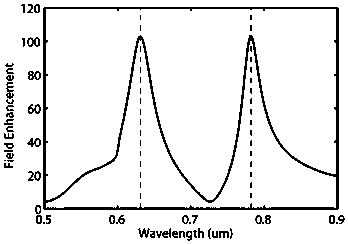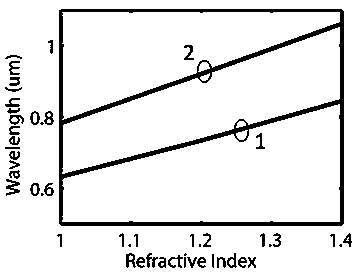Antenna-assisted dual-wavelength multifunctional sensing element, preparation method and application
A sensing element and dual-wavelength technology, applied in the field of sensing, can solve the problems that the enhancement effect needs to be further improved, and achieve convenient biological detection, improve the effect of Raman enhancement, and improve the effect of Raman enhancement
- Summary
- Abstract
- Description
- Claims
- Application Information
AI Technical Summary
Problems solved by technology
Method used
Image
Examples
Embodiment 1
[0034] A specific embodiment of the present invention is given below. Set the gold substrate to be thick enough that no light can pass through; the periods along the long axis and short axis of the gold bowtie are 0.6um and 0.4um respectively; the height of the gold bowtie and the gold bar are both 0.055nm; the width of the gold bar is 0.1um; The height of the two isosceles triangles that make up the golden bow tie is 0.14um, the apex angle is 50°, and the gap between the apex angles is 0.01um. This embodiment is designed to use 0.633um laser to excite and detect 0.78um (3000cm -1 ) near the Raman scattering signal. The position of the first resonance peak can be adjusted to match the wavelength of the excitation light by adjusting the height of the apex to the base of a pair of isosceles gold triangles that make up the golden bow tie. Adjusting the height of the golden bowtie can adjust the position of the second formant to match the wavelength of the Raman signal to be det...
Embodiment 2
[0039] The antenna-assisted dual-wavelength multifunctional sensing element of the present invention can be prepared by the following steps: sputter 0.2um gold on any flat substrate as a substrate, and the thickness is enough to prevent light from passing through. The 0.18um positive photoresist PMMA950K is spin-coated on the gold substrate. The thickness of the photoresist and the thickness of the construction material are about 3:1 to ensure the feasibility of the subsequent stripping process. The bowtie-strip structure is exposed on the photoresist by electron beam exposure technique. After development, the exposed part is washed off, leaving bowtie-strip pits, and 0.055um gold is directional evaporated in these pits. After cleaning off the residual glue, a gold bow tie-gold bar periodic arrangement structure is left on the substrate.
[0040] By designing different structures, the double peak structure of the present invention can be applied to different excitation and sc...
PUM
 Login to View More
Login to View More Abstract
Description
Claims
Application Information
 Login to View More
Login to View More - R&D
- Intellectual Property
- Life Sciences
- Materials
- Tech Scout
- Unparalleled Data Quality
- Higher Quality Content
- 60% Fewer Hallucinations
Browse by: Latest US Patents, China's latest patents, Technical Efficacy Thesaurus, Application Domain, Technology Topic, Popular Technical Reports.
© 2025 PatSnap. All rights reserved.Legal|Privacy policy|Modern Slavery Act Transparency Statement|Sitemap|About US| Contact US: help@patsnap.com



